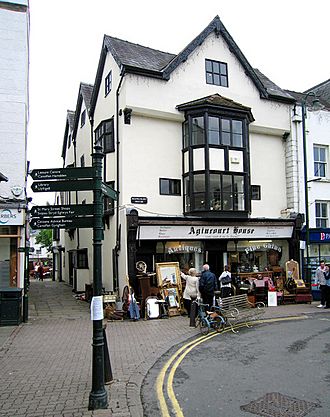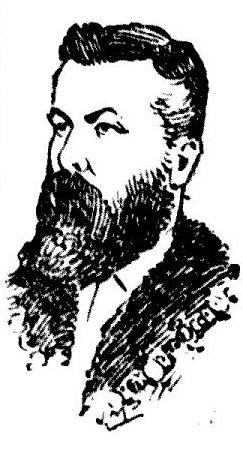Agincourt House, Monmouth facts for kids
Quick facts for kids Agincourt House |
|
|---|---|

Agincourt House in 2009; the antiques business has since closed
|
|
| General information | |
| Address | No. 1 Agincourt Square |
| Town or city | Monmouth |
| Country | Wales |
| Coordinates | 51°48′44.9″N 2°42′55.0″W / 51.812472°N 2.715278°W |
| Construction started | 1624 |
Agincourt House, found at No. 1 Agincourt Square in Monmouth, Wales, is a very old and interesting building. It was built in the early 1600s and is famous for its unique half-timbered style. This means it has a wooden frame that you can see on the outside, with the spaces in between filled with other materials. It's a special part of Monmouth's history!
Contents
Discovering Agincourt House's Past
Agincourt House has been carefully repaired and updated many times over the years. A special wooden board above the main entrance, called a bargeboard, shows the year 1624. This tells us when the house was built. The letters next to the date are for William Roberts, whose grandson later rebuilt another famous house in Monmouth called Drybridge House.
This building is so important that it's been given a special status called "Grade II*" since 1952. This means it's a building of more than special interest and needs to be protected. Agincourt House is also one of the 24 amazing places you can see on the Monmouth Heritage Trail.
What Was Here Before?
Even before Agincourt House was built, there was a house on this spot. We know this from an old map of Monmouth made by John Speed in 1610. The way the streets were laid out on that map stayed the same for a very long time, even until the 1800s!
The front of the shop you see today was added much later, in the late 1800s. For many years, from about 1830 until the end of the 19th century, Agincourt House was a shop that sold metal goods, called an ironmonger's.
Famous Shop Owners
In 1830, the owner was Josiah Coates. Besides being an ironmonger, he also worked as a blacksmith, a brazier (someone who works with brass), and a tinplate worker.
Later, from the early 1860s to 1883, Joseph Coates ran the shop. You could even see the words 'Furnishing' and 'Ironmonger' on the shop sign next to his name. Joseph Coates did many jobs, including blacksmith, nailmaker, locksmith, and bellhanger. He was also a singer in the choir and a church warden at St Mary's Priory Church. It's even said that John Major, who was the UK Prime Minister from 1990 to 1997, is related to the Coates family!
From 1884, another ironmonger named William Honeyfield took over the shop. He was a very important person in Monmouth and served as the Mayor of Monmouth from 1891 to 1895. He was also a Mason and part of the bell-ringing team at St Mary's Priory Church. He even took part in a special bell-ringing event in 1896, which is remembered on a plaque in the church's bell tower.
What is Agincourt House Today?
Over the years, Agincourt House has had many different uses:
- In 1919, it was used by the YMCA (Young Men's Christian Association).
- In the early 1920s, it became a shoe shop called Cash & Co. If you look carefully, you can still see their name in the mosaic floor at the front entrance!
- By 1934, it was another shoe shop, W. & E. Turner Ltd.
- In the 1980s, a butcher's shop called 'Le Gourmet' was there for a while.
After the butcher's shop moved out, the building was carefully restored. It even won an award from the Monmouth Civic Society in 1991 for its great restoration work. From 1992 until 2010, it was an antiques shop. Today (as of 2012), it's a clothes shop on the ground floor, with offices on the upper floors.


